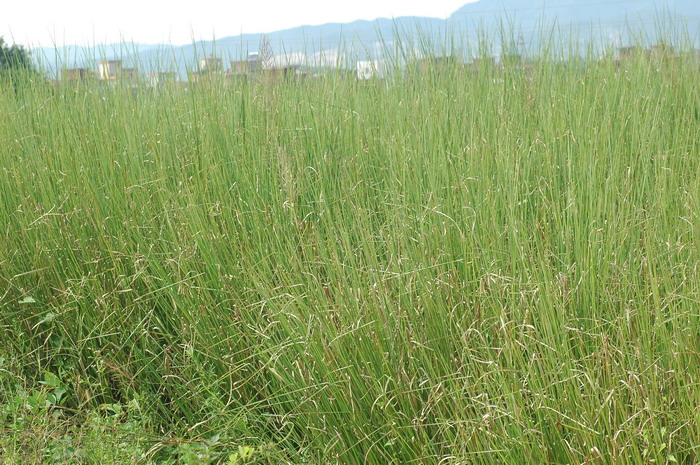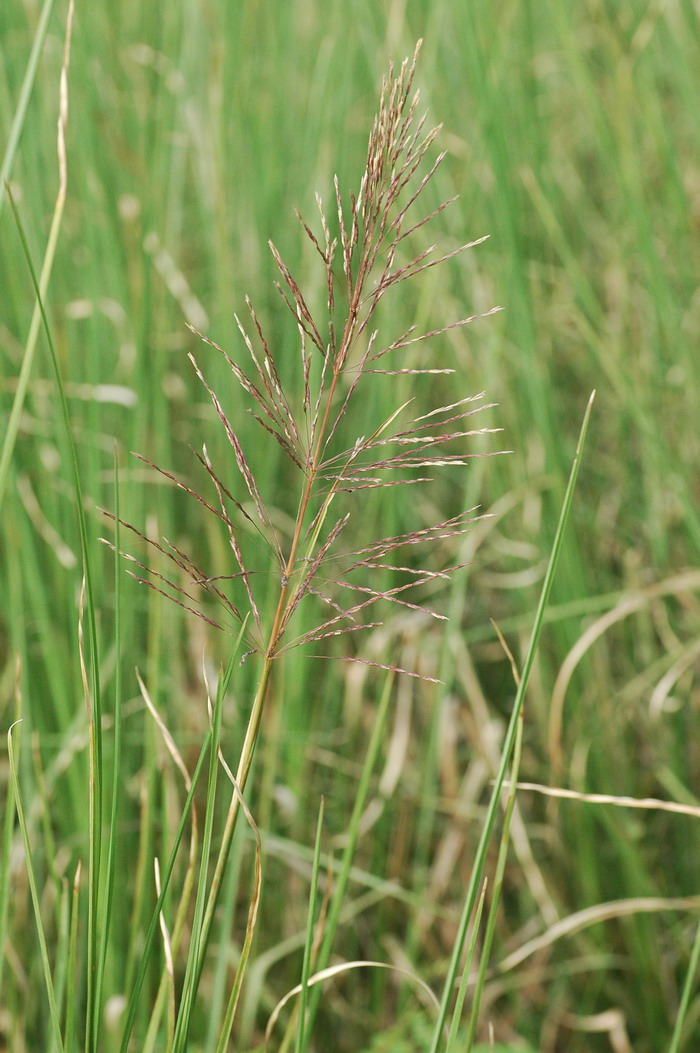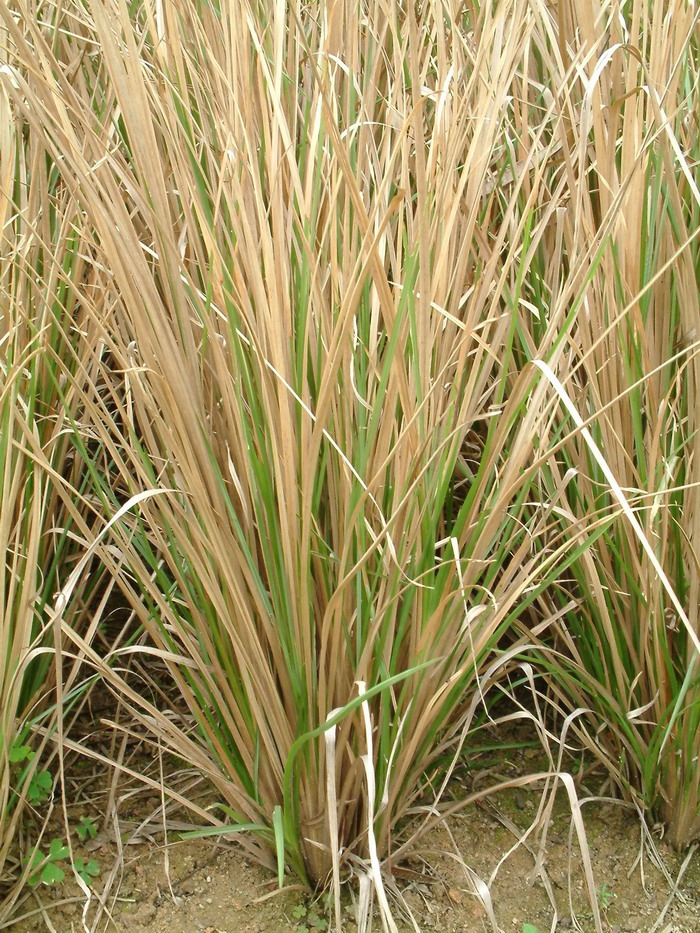香根草Vetiveria zizanioides
中文名(Chinese Name):香根草
学名(Scientific Name):Vetiveria zizanioides (L.) Nash
英文名(English Common Name):vetivergrass
别名(Chinese Common Name):岩兰草
异名(Synonym):Vetiveria zizanioides (Linn.) Nash Phalaris zizanioides L. Vetiveria zizanioides var. tonkinensis A.Camus Vetiveria odoratissima Lem.-Lis. Vetiveria zizanioides var. genuina A.Camus Vetiveria arundinacea Griseb. Vetiveria muricata (Retz.) Griseb. Sorghum zizanioides (L.) Kuntze Anatherum muricatum (Retz.) P.Beauv. Vetiveria odorata Virey Rhaphis muricata (Retz.) Steud. Holcus zizanioides (L.) Stuck. Andropogon muricatus Retz. Andropogon muricatum Retz. Andropogon aromaticus Roxb. ex Schult. Chamaeraphis muricata (Retz.) Merr. Andropogon zizanioides (L.) Urb. Rhaphis zizanioides (L.) Roberty
科属(Family & Genus):禾本科(Gramineae)香根草属
形态特征(Description):多年生粗壮草本。须根含挥发性浓郁的香气。秆丛生,高1-2.5米,直径约5毫米,中空。叶鞘无毛,具背脊;叶舌短,长约0.5毫米,边缘具纤毛;叶片线形,直伸,扁平,下部对折,与叶鞘相连而无明显的界线,长30-70厘米,宽5-10毫米,无毛,边缘粗糙,顶生叶片较小。圆锥花序大型顶生,长20-30厘米;主轴粗壮,各节具多数轮生的分枝,分枝细长上举,长10-20厘米,下部长裸露;总状花序轴节间与小穗柄无毛;无柄小穗线状披针形,长4-5毫米,基盘无毛;第一颖革质,背部圆形,边缘稍内折,近两侧压扁,5脉不明显,疏生纵行疣基刺毛;第二颖脊上粗糙或具刺毛;第一外稃边缘具丝状毛;第二外稃较短,具1脉,顶端2裂齿间伸出一小尖头;鳞被2,顶端截平,具多脉;雄蕊3,柱头帚状,花期自小穗两侧伸出。有柄小穗背部扁平,等长或稍短于无柄小穗。染色体2n=20 (Christopher,1978)。花果期8-10月。
分布(Distribution):产热带非洲至印度、斯里兰卡、泰国、缅甸、爪哇,喜生水湿溪流旁和疏松粘壤土上,我国南方引种栽培。
用途(Use):须根含香精油,油浓褐色,稠性大,紫罗兰香型,挥发性低,用作定香剂。幼叶是良好饲料。茎秆可作造纸原料。
引自中国植物志英文版FOC Vol. 22 Page 603
Chrysopogon zizanioides (Linnaeus) Roberty, Bull. Inst. Franç. Afrique Noire. 22: 106. 1960.
香根草 xiang gen cao | Poaceae | Chrysopogon
Phalaris zizanioides Linnaeus, Mant. Pl. 2: 183. 1771; Vetiveria zizanioides (Linnaeus) Nash.
Tussocky perennial; roots stout, aromatic. Culms robust, 1–2.5 m tall, ca. 5 mm in diam. Leaf sheaths glabrous, lower sharply keeled and imbricate in fanlike clusters; leaf blades linear, pale green, stiff, 30–90 × 0.5–1 cm, pilose on adaxial surface toward base, otherwise glabrous; ligule a scarious rim. Panicle oblong in outline, 20–30 cm, usually contracted, purplish; branches numerous, lowermost 5–20 cm, bare at base, smooth or slightly scaberulous; racemes slender, with 5–13 spikelet pairs and a terminal triad; internodes and pedicels slightly scabrid. Sessile spikelet linear-lanceolate to almost linear, 4–5 mm; callus rounded, subglabrous; lower glume muricate, 3–5-veined, veins spinulosely aculeate, apex acute; upper glume spinulosely aculeate on keel, not awned; upper lemma slightly 2-toothed, awnless or mucronate; mucro 0–2 mm, not exserted. Pedicelled spikelet staminate, sparingly aculeolate or almost smooth. Fl. and fr. Aug–Oct. 2n = 20.
Commonly cultivated. Fujian, Guangdong, Hainan, Jiangsu, Sichuan, Taiwan, Yunnan (Xixhuangbanna), Zhejiang [native to India; cultivated elsewhere].
This species (Vetiver Grass) is said to have originated in India, but is now distributed throughout warm parts of the Old World and introduced into the S United States and West Indies. It has long been cultivated for the oil extracted from the aromatic roots, which is used in perfumery. More recently, its potential as a soil binder to prevent erosion has been recognized. It is planted in hedges for this purpose, particularly along the contours of sloping ground. The deep, non-invasive root system holds the plants firm, while the stiff, dense leaves trap soil and prevent it being washed away. It is also used as a forage grass.



(责任编辑:徐晔春)
学名(Scientific Name):Vetiveria zizanioides (L.) Nash
英文名(English Common Name):vetivergrass
别名(Chinese Common Name):岩兰草
异名(Synonym):Vetiveria zizanioides (Linn.) Nash Phalaris zizanioides L. Vetiveria zizanioides var. tonkinensis A.Camus Vetiveria odoratissima Lem.-Lis. Vetiveria zizanioides var. genuina A.Camus Vetiveria arundinacea Griseb. Vetiveria muricata (Retz.) Griseb. Sorghum zizanioides (L.) Kuntze Anatherum muricatum (Retz.) P.Beauv. Vetiveria odorata Virey Rhaphis muricata (Retz.) Steud. Holcus zizanioides (L.) Stuck. Andropogon muricatus Retz. Andropogon muricatum Retz. Andropogon aromaticus Roxb. ex Schult. Chamaeraphis muricata (Retz.) Merr. Andropogon zizanioides (L.) Urb. Rhaphis zizanioides (L.) Roberty
科属(Family & Genus):禾本科(Gramineae)香根草属
形态特征(Description):多年生粗壮草本。须根含挥发性浓郁的香气。秆丛生,高1-2.5米,直径约5毫米,中空。叶鞘无毛,具背脊;叶舌短,长约0.5毫米,边缘具纤毛;叶片线形,直伸,扁平,下部对折,与叶鞘相连而无明显的界线,长30-70厘米,宽5-10毫米,无毛,边缘粗糙,顶生叶片较小。圆锥花序大型顶生,长20-30厘米;主轴粗壮,各节具多数轮生的分枝,分枝细长上举,长10-20厘米,下部长裸露;总状花序轴节间与小穗柄无毛;无柄小穗线状披针形,长4-5毫米,基盘无毛;第一颖革质,背部圆形,边缘稍内折,近两侧压扁,5脉不明显,疏生纵行疣基刺毛;第二颖脊上粗糙或具刺毛;第一外稃边缘具丝状毛;第二外稃较短,具1脉,顶端2裂齿间伸出一小尖头;鳞被2,顶端截平,具多脉;雄蕊3,柱头帚状,花期自小穗两侧伸出。有柄小穗背部扁平,等长或稍短于无柄小穗。染色体2n=20 (Christopher,1978)。花果期8-10月。
分布(Distribution):产热带非洲至印度、斯里兰卡、泰国、缅甸、爪哇,喜生水湿溪流旁和疏松粘壤土上,我国南方引种栽培。
用途(Use):须根含香精油,油浓褐色,稠性大,紫罗兰香型,挥发性低,用作定香剂。幼叶是良好饲料。茎秆可作造纸原料。
引自中国植物志英文版FOC Vol. 22 Page 603
Chrysopogon zizanioides (Linnaeus) Roberty, Bull. Inst. Franç. Afrique Noire. 22: 106. 1960.
香根草 xiang gen cao | Poaceae | Chrysopogon
Phalaris zizanioides Linnaeus, Mant. Pl. 2: 183. 1771; Vetiveria zizanioides (Linnaeus) Nash.
Tussocky perennial; roots stout, aromatic. Culms robust, 1–2.5 m tall, ca. 5 mm in diam. Leaf sheaths glabrous, lower sharply keeled and imbricate in fanlike clusters; leaf blades linear, pale green, stiff, 30–90 × 0.5–1 cm, pilose on adaxial surface toward base, otherwise glabrous; ligule a scarious rim. Panicle oblong in outline, 20–30 cm, usually contracted, purplish; branches numerous, lowermost 5–20 cm, bare at base, smooth or slightly scaberulous; racemes slender, with 5–13 spikelet pairs and a terminal triad; internodes and pedicels slightly scabrid. Sessile spikelet linear-lanceolate to almost linear, 4–5 mm; callus rounded, subglabrous; lower glume muricate, 3–5-veined, veins spinulosely aculeate, apex acute; upper glume spinulosely aculeate on keel, not awned; upper lemma slightly 2-toothed, awnless or mucronate; mucro 0–2 mm, not exserted. Pedicelled spikelet staminate, sparingly aculeolate or almost smooth. Fl. and fr. Aug–Oct. 2n = 20.
Commonly cultivated. Fujian, Guangdong, Hainan, Jiangsu, Sichuan, Taiwan, Yunnan (Xixhuangbanna), Zhejiang [native to India; cultivated elsewhere].
This species (Vetiver Grass) is said to have originated in India, but is now distributed throughout warm parts of the Old World and introduced into the S United States and West Indies. It has long been cultivated for the oil extracted from the aromatic roots, which is used in perfumery. More recently, its potential as a soil binder to prevent erosion has been recognized. It is planted in hedges for this purpose, particularly along the contours of sloping ground. The deep, non-invasive root system holds the plants firm, while the stiff, dense leaves trap soil and prevent it being washed away. It is also used as a forage grass.
(责任编辑:徐晔春)
踩一下[0]

顶一下[1]